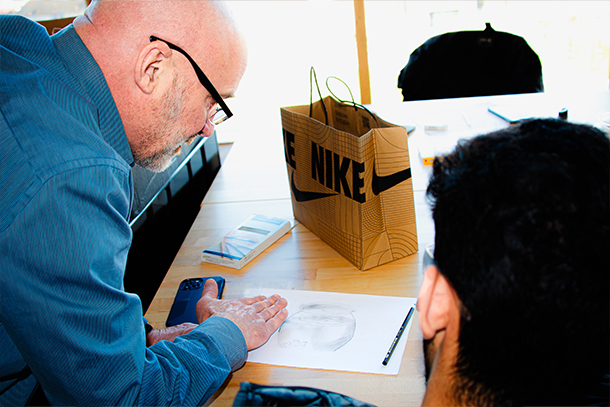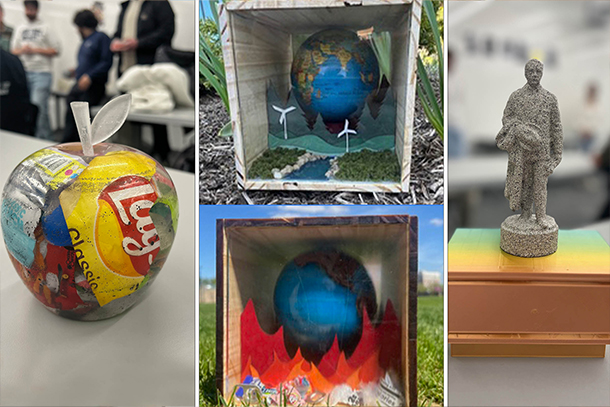
The course “If Picasso Were An Engineer," offered through the Penn State School of Engineering Design and Innovation and funded by the Leonhard Center for the Enhancement of Engineering Education, is part of an effort in the Penn State College of Engineering to incorporate artistic principles into the engineering student experience. Credit: Compilation of student work provided by Benjamin Fehl/Tim Schley/Penn State.
What If Picasso Were an Engineer?
Engineering students trade in equations for easels in an engineering design course that helps them step outside their comfort zone
June 14, 2024
By Tim Schley
UNIVERSITY PARK, Pa. — Inside the new Engineering Design and Innovation Building on Penn State’s University Park campus, a class of engineering students gather, eager to apply their growing technical acumen to tomorrow’s global issues. But first, they must confront today’s immense hurdle: drawing a line on a blank piece of paper.
“We talk a lot about the idea of a blank canvas because that’s what we’re scared of,” said Benjamin Fehl, lecturer in the Penn State School of Engineering Design and Innovation (SEDI). “It’s a simple thing, but so important — drawing a confident line.”
Fehl recently taught the inaugural semester of "EDSGN 497: If Picasso Were An Engineer,” an elective engineering design course where students trade in equations for easels and explore how art can help them unlock their creativity. This course aims to help students — many of whom have little-to-no previous art experience — step outside their comfort zone and hone their skills for conceptualization, presentation and reflection.
It is also part of a broader effort to incorporate art into engineering education at Penn State with the goal of helping engineering students benefit from a different creative vantage point.
“There are skills that both engineers and artists need and use, which include communication, tolerance for ambiguity and creativity,” said Sarah Zappe, assistant dean for teaching and learning in the College of Engineering and director of the Leonhard Center for Enhancement of Engineering Education. The course was funded through a Leonhard Center grant specifically related to projects that integrate art with engineering. “One of the easiest ways to connect art into engineering is in the design process. By incorporating art into an engineering design course, students have the potential to become stronger and more innovative designers.”

There is unlimited potential intrinsic to a blank canvas — anything can appear on the page if it can be conceptualized in the mind and rendered through a trained hand, according to instructor Benjamin Fehl. IMAGE: Credit: Tim Schley/Penn State
Scaling artistry
According to Fehl, one of his main goals with the course was to give open-ended projects to help the students learn how to design without a prescribed set of directions. However, he found that this could be intimidating for some of the students, who may have preferred more direct, “solve-for-x” instructions.
To help them think outside of the box, Fehl did the same, taking advantage of winter weather and cancelled classes at the University Park campus to create an unconventional assignment: Build a durable and creative snow sculpture.
Mechanical engineering major Eva Koczur chose to show her Penn State pride by designing and building a larger-than-life Nittany Lion Shrine, gaining the attention of local media.
“It’s kind of a stereotype that engineers have no other skills besides solving math problems and doing science and stuff, and so I really like … changing the narrative,” she told the Daily Collegian.
Early in the semester, Fehl assigned collage projects to help the students grapple with their fear of the blank canvas. As their confidence grew, they worked up to sketching. By April, renderings in the sketchbook varied from a glass of water — an exercise to help them break down mental barriers by only shading the drawing rather than sketching with edge lines — to a draft of the nearby Earth and Engineering Science Building.
And then the blank canvas sat next to a bowl with a live fish.

“I don’t expect it to be easy to get into this exercise,” Fehl said to the class in April as he unveiled the glass bowls to the nervous laughter of the class. Once students began, they were deep in concentration — furrowed brows, tongues sticking out, an occasional thumb in the air to measure for scale. Credit: Poornima Tomy/Penn State.
In this challenging exercise, students would need to build on what they’ve learned to capture a still image in their minds of the moving fish, visualize how they would like to render details like the shape of a fin or discolored scale and translate this mental image to the paper for others to see, too.
“Don’t forget to name your fish,” Fehl said to the class amid the quiet scratching of graphite. “Who’s a great creator? How about Isaac Newton?”
To make, or not to make?
“In engineering, we put Newton’s maxim ‘If I have seen further than others, it is by standing on the shoulders of giants’ into practice every day, except we don’t know who those giants are or why they did what they did,” said Matt Parkinson, director of the Penn State Learning Factory. “Our colleagues in the College of Arts and Architecture have a respect for what has gone before that I really admire.”
In addition to the twice-weekly classes in the new Engineering Design and Innovation Building, Fehl held weekly workshop hours for small-group coaching and inspiration in the facility’s floor-wide makerspace on the fourth floor. This space is also home to the Learning Factory, which, in addition to coordinating hands-on learning experiences like first-year cornerstone and fourth-year capstone projects, also organized an “Artist in Residence Build Night” series for engineering students to explore their creativity alongside artists in the College of Arts and Architecture. The Artist in Residence series was also sponsored by the Leonhard Center.
"These opportunities nurture whatever creativity is within us that can’t always be expressed in traditional engineering curricula," said Learning Factory director Matt Parkinson. Credit: Tyler Henderson/Penn State.
“Opportunities like these teach new skills and new perspectives, ultimately adding new tools to the engineering toolbox,” Parkinson said. “We have to be open to — and see value in — those perspectives, and that’s a big step for some of us.”
According to Fehl, the fourth-floor makerspace offered the space and visual inspiration for young engineers to reflect on how their work fits into the world around them. How do their creations build on the work of others? How do they inspire or elevate the human experience? And who will be influenced, both now and in the future?
These questions formed the basis for a semester-long project: Create an “artifact” for a time capsule.
“Engineers look at artifacts all the time — what is an artifact?” Fehl said. “What we see today is going to have different meaning in 50 years. To them, it’s a really abstract idea because they haven’t had as many experiences to warrant that additional layer of perspective. I think it’s a wonderful thing to impart.”
In groups, they worked together throughout the semester to find order through the chaos of self-expression, creating unique artifacts that showed glimpses of how they perceived the world around them, Fehl said. These included a 3D-printed model of Harry Parker Hammond, dean of the College of Engineering from 1937 to 1951, on top of Hammond Building; a resin apple filled with trash; and a dual-sided collage depicting two contrasting futures of the planet Earth.

The etymology of the word “artifact” derives from the Latin “arte” – by or using art – and “factum” – something made. Credit: Sarah Zappe, Benjamin Fehl/Penn State
By the end of the semester, the students’ newfound artistic confidence had started paying dividends in other areas of their education, said Aaron Kern, who recently graduated with a bachelor’s degree in aerospace engineering.
“For my capstone, I hand sketched some initial sketches [of a rotorcraft drone],” Kern said. “I wouldn’t have done that [before taking this class]. It’s really helped us communicate our ideas to our professors.”
They just needed to draw that first line on the piece of paper and start conceptualizing. “Once they get through that, it’s amazing what they can achieve,” he said.

